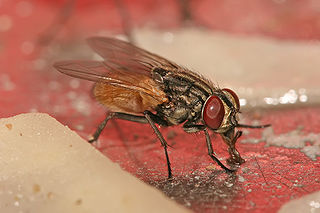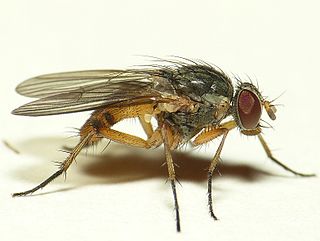
Moravia is a historical region in the east of the Czech Republic and one of three historical Czech lands, with Bohemia and Czech Silesia.

Nightjars are medium-sized nocturnal or crepuscular birds in the family Caprimulgidae and order Caprimulgiformes, characterised by long wings, short legs, and very short bills. They are sometimes called bugeaters, their primary source of food being insects. Some New World species are called nighthawks. The English word "nightjar" originally referred to the European nightjar.

Brno is a city in the South Moravian Region of the Czech Republic. Located at the confluence of the Svitava and Svratka rivers, Brno has about 400,000 inhabitants, making it the second-largest city in the Czech Republic after the capital, Prague, and one of the 100 largest cities of the European Union. The Brno metropolitan area has approximately 720,000 inhabitants.

The South Moravian Region, or just South Moravia, is an administrative unit of the Czech Republic, located in the south-western part of its historical region of Moravia. The region's capital is Brno, the nation's 2nd largest city. South Moravia is bordered by the South Bohemian Region to the west, Vysočina Region to the north-west, Pardubice Region to the north, Olomouc Region to the north-east, Zlín Region to the east, Trenčín and Trnava Regions, Slovakia to the south-east and Lower Austria, Austria to the south.

The Masaryk circuit or Masarykring, also referred to as the Brno Circuit, refers to two motorsport race tracks located in Brno, Czech Republic. The original street circuit was made up of public roads, and at its longest measured 29.194 km (18.140 mi). In 1949, events such as the Czechoslovakian Grand Prix attracted top teams and drivers. The track is named after the first president of Czechoslovakia, Tomáš Garrigue Masaryk. Racing on the old roads ended after 1986, when the new (current) circuit was opened. Since August 2023, the circuit is owned by Shakai.

FC Zbrojovka Brno is a professional football club based in the city of Brno, South Moravian Region, Czech Republic and named after Zbrojovka Brno, a firearms manufacturer. Founded in 1913 as SK Židenice, the club later became known as Zbrojovka Brno. Brno won the Czechoslovak First League in the 1977–78 season and finished as runners-up in 1979–80.

Muscidae are a family of flies found in the superfamily Muscoidea.

The Fanniidae are a small group of true flies largely confined to the Holarctic and temperate Neotropical realms; there are 11 Afrotropical species, 29 Oriental, and 14 Australasian.

There are an estimated 20,000 Muslims in the Czech Republic, representing 0.2% of the country's population. The growing Turkish community form the largest Muslim population in the country.

The Coelopidae or kelp flies are a family of Acalyptratae flies, they are sometimes also called seaweed flies, although both terms are used for a number of seashore Diptera. Fewer than 40 species occur worldwide. The family is found in temperate areas, with species occurring in the southern Afrotropical, Holarctic, and Australasian regions.

Fannia is a very large genus of approximately 288 species of flies. The genus was originally described by the French entomologist Jean-Baptiste Robineau-Desvoidy in 1830. A number of species were formerly placed in the genus Musca.
Euryomma is a genus of species of flies of the family Fanniidae. The genus was originally proposed by the entomologist Paul Stein in 1899. Although at that time most authorities placed them in the family Muscidae. The distribution of Euryomma is mainly Neotropical, on the whole restricted to the Americas, there is also one Nearctic species, the exception being of the very cosmopolitan E. peregrinum

Piezura is a small genus of small flies of the family Fanniidae. Distribution is mostly restricted to the Holarctic biogeographic region. Two species, P. pardalina and P. graminicola are found in Europe. Unlike the other Fanniidae, Piezura have plumose arista.

Vranovice is a municipality and village in Brno-Country District in the South Moravian Region of the Czech Republic. It has about 2,400 inhabitants.

Rugby union in Czechoslovakia was a moderately popular sport. It was most popular in Moravia, Prague and Bratislava

The Brno tramway network was the first network of its kind to be put into operation in what is now known as the Czech Republic with its horse tram lines dating back to 1869. Today, Brno is the second largest city in the Czech Republic, after Prague, and its tram network is also the second largest in the country.

Petr Fiala is a Czech politician and political scientist who has been the prime minister of the Czech Republic since November 2021 and leader of the Civic Democratic Party (ODS) since 2014. He previously served as the Minister of Education, Youth and Sports from 2012 to 2013. Prior to entering politics, he was the rector of Masaryk University.

Brno Zoo is a zoo located in Brno-Bystrc, a municipal district of the city of Brno, Czech Republic. It was opened in 1953.
Euryomma muisca is a species of fly in the genus Euryomma. It was first described by Grisales et al. in 2012.
Euryomma arcuata is a species of fly in the genus Euryomma. It was first described by James Gordon Thomas Chillcott in 1961. It occurs in North America. Its occipital bristles are long with a full postoccipital row.
















